
The Buthidae are the largest family of scorpions, containing about 96 genera and over 1230 species as of 2021. Its members are known as, for example, fat-tailed scorpions and bark scorpions. A few very large genera are known, but a high number of species-poor or monotypic ones also exist. New taxa are being described at a rate of several new species per year. They occur in the warmer parts of every major landmass on Earth, except Antarctica and New Zealand. Together with four other families, the Buthidae make up the superfamily Buthoidea. The family was established by Carl Ludwig Koch in 1837.
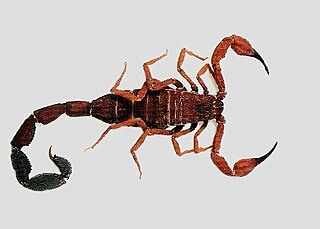
Tityus is a large genus of thick-tailed scorpions, the namesake of its subfamily Tityinae. As of 2021, Tityus contains more than 220 described species distributed in Central America and South America, from Costa Rica to Argentina.
Tityus pintodarochai is a species of scorpion belonging to the family Buthidae. It is only known from a single female collected in Paraná state, Brazil.
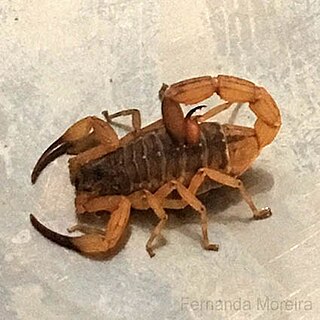
Tityus serrulatus, the Brazilian yellow scorpion, is a species of scorpion of the family Buthidae. It is native to Brazil, and its venom is extremely toxic. It's the most dangerous scorpion in South America and responsible by the most fatal cases.
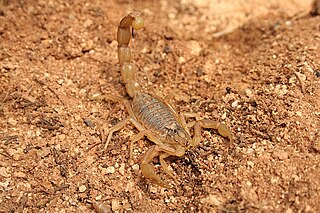
Buthus is a genus of scorpion belonging and being eponymous to the family Buthidae. It is distributed widely across northern Africa, including Morocco, Mauritania, Algeria, Tunisia, Libya, Egypt, Senegal, Guinea-Bissau, Nigeria, Sudan, Somalia, Ethiopia, Djibouti, as well as the Middle East, including Israel, Palestine, Jordan, Lebanon, Iraq, Yemen, and possibly Saudi Arabia and southern Turkey. Its European range includes the Iberian Peninsula, southern France, and Cyprus.
Tityus fasciolatus is a species of scorpion from the family Buthidae. The species are 4.5–8.5 centimetres (1.8–3.3 in) in length and are yellowish-brown coloured. They also have three dark stripes over the mesosoma with either yellowish or orange pedipalps, which have dark spots as well. Their first to third segments of metasoma is yellowish-orange, with the fourth one being reddish. Their fifth and final segment id dark red coloured. The species have yellow coloured legs which have dark spots, which are the same as on pedilap. Their tarsus is dark in colour with pectines that have 17-25 teeth, in which they have 16-18 rows of granules. T. fasciolatus is a species of medical importance, its venom is molecular and very similar to T. serrulatus, its venom contains at least 10 toxic fractions, with molecular masses ranging from 6 to 10-80 kDa, the LD50 for this species is 2.984 mg / kg.
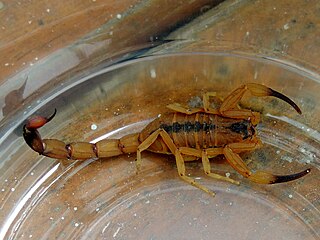
Tityus stigmurus is a species of scorpion from the family Buthidae that can be found in Brazil. The species are 4.5–6 centimetres (1.8–2.4 in) in length and are either golden-tan or yellowish-brown coloured. It takes them a year to mature into an adult, which makes them a fast-growing species. They also have a dark stripe over the mesosoma with either yellowish or orange pedipalps.
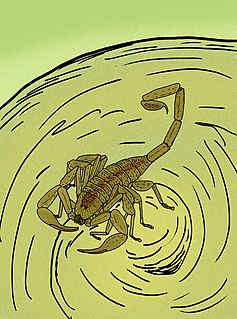
Tityus exstinctus is an extinct species of scorpion belonging to the family Buthidae. It is only known from a single male collected in 1884 in the northern range of Martinique. The species epithet based on the fact that this taxon was already extinct when it was described.
Tityus tenuicauda is a species of scorpions in the family Buthidae. This species is endemic to the island of Trinidad in Trinidad and Tobago.

Buthoidea is the largest superfamily of scorpions. Its members are known as fat-tailed scorpions and bark scorpions. A few very large genera are known, but a high number of species-poor or monotypic ones also exist. They occur in the warmer parts of every major landmass on Earth, except on New Zealand. The superfamily was established by Carl Ludwig Koch in 1837.

Bactridines are a group of six antibacterial peptides from the venom of the Tityusdiscrepans scorpion. They exclusively target sodium channels. Bactridines are unique in that this scorpion toxin acts on sodium channels of both bacteria and eukaryotes.
TsIV is a toxin from the venom of the Brazilian scorpion Tityus serrulatus which slows the inactivation of sodium channels.
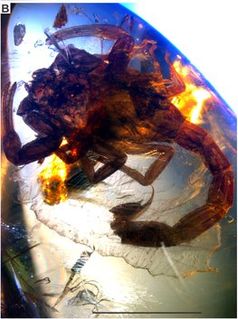
Tityus apozonalli is an extinct species of scorpion in the family Buthidae known from a fossil found in North America. The species is one of two scorpions described from Mexican amber and one of seven species from Central American amber deposits.
Ananteris nairae is a scorpion species found in Brazilian Amazonia. The species has the most western distribution of the species in Ananteris. The specific epithet refers to Nair Otaviano Aguiar.
Tityustoxin peptide 2 (TsPep2) is a peptide isolated from the venom of the Tityus serrulatus. It belongs to a class of short peptides, together with Tityustoxin peptide 1 and Tityustoxin peptide 3.
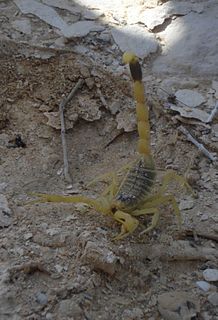
Leiurus abdullahbayrami is a species of scorpion in the family Buthidae. Its venom is highly toxic to humans, but can be used in medical development.

Scorpionism is defined as the accidental envenomation of humans by toxic scorpions. If the injection of venom in a human results in death, this is defined as scorpionism. This is seen all over the world but is predominantly seen in the tropical and subtropical areas. These areas include Mexico, northern South America and southeast Brazil in the Western hemisphere. In the Eastern hemisphere, scorpionism possess a public health threat in the regions of South Africa, the Middle East, and the Indian subcontinent.

Scorpionism is defined as the accidental envenomation of humans by toxic scorpions. If the injection of venom in a human results in death, this is defined as scorpionism. This is seen all over the world but is predominantly seen in the tropical and subtropical areas. These areas include Mexico, northern South America and southeast Brazil in the Western hemisphere. In the Eastern hemisphere, scorpionism poses a public health threat in regions of South Africa, the Middle East, and the Indian subcontinent.

Tityus silvestris is a species of arachnid endemic to northern South America.
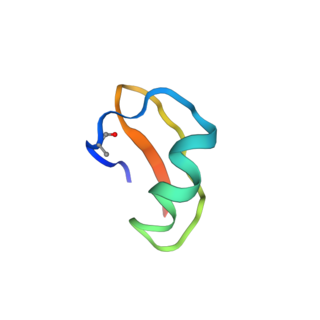
The Tst26 toxin is a voltage-gated potassium channel blocker present in the venom of Tityus stigmurus, a species of Brazilian scorpion. Tst26 selectively blocks Kv1.2 and Kv1.3 channels.











